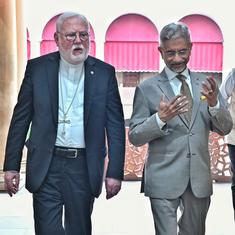Just two months after India attained independence, its cricket team travelled to Australia to play one of the greatest Test sides ever. This was to be Don Bradman’s last series at home and the only opportunity for India to face him.
Bradman was 39 by then and beset with a series of health problems, but when he was asked to lead the Australian side, he said yes. “Believing that the season against India in 1947-8 would be less exacting and that now I was better able to stand up to it, I again felt it my duty to play this one season, especially as it was to be the first tour of Australia by an Indian team,” Bradman wrote in his 1950 autobiography Farewell to Cricket. “At that time I was still very dubious about attempting a final tour of England.”
For the tourists, the challenge was onerous. India had played Tests since its first match at Lord’s in June 1932 but not won a single one. Besides, their star players including Vijay Merchant had pulled out at the start of the tour because of injuries.
Bradman was disappointed. He seemed to have a great deal of respect for Merchant, who was originally named captain for the tour. “Vijay Merchant had earned a place amongst the leading batsmen of the day with others not so far behind,” he wrote. “...There were other withdrawals too, of prominent players which must have affected the overall strength of the team. But it was the loss of Merchant that I think was mainly responsible for India’s relatively poor performances in the Test matches.”
While injuries deprived India of Merchant and Rusi Modi, the Partition took away some of its other quality players. The bowling great Fazal Mahmood was among the early ones to go over to the newly-formed nation of Pakistan. Others who joined later included a few from that touring Indian team, such as Amir Elahi and Gul Mohammed, both of whom would end playing for Pakistan. Wicketkeeper Jamshed ‘Jenni’ Irani, who played for Sindh, would live out his life in Karachi.
K.S. Duleepsinhji, Don Bradman and Lala Amarnath at a Reception In Adelaide During India - Australia 1947-48 Series.
— indianhistorypics (@IndiaHistorypic) January 7, 2019
( Photo - The Hindu Newspaper ) pic.twitter.com/RszgBp7SVm
“By sterling performances in their own country against visiting teams, the Indian cricketers obviously possessed considerable skill,” Bradman said. “In tours of England they had shown likewise, but the variable weather and the lack of sunshine probably caused them to be unreliable.”
Pitch imperfect
Hoping for a competitive series, the Australian cricket authorities felt it would be more advantageous for India if the wickets remained covered. But India wanted to follow Melbourne Cricket Club’s practice of uncovered wickets. “I thought India was making a grave mistake,” Bradman wrote. “We do not see many wet wickets in this country, but we see more than the Indians do in theirs.”
A covered wicket or pitch is one that has been protected against the elements, like the sun and the rain, to make the ball’s behaviour on it more predictable. In contrast, an uncovered pitch can be wetter, drier or more uneven, giving bowlers an upper hand.
Bradman tried to persuade substitute Indian captain Lala Amarnath to agree to covered wickets, but to no avail. “Knowing the merits of the players who would be at our disposal, I felt that on wet wickets India would be overwhelmed,” he wrote. Amarnath probably saw the wisdom of Bradman’s suggestion, but was willing to “trust the favouritism of the weather gods”.
In the end, India lost the five-match series 4-0. One of the Tests was a draw, on account of rain.
Lala Amarnath and Don Bradman inspect the pitch at Sydney, 1947-48. pic.twitter.com/y9paZdVzBU
— Rameshwar Singh (@RSingh6969a) January 3, 2021
Bradman felt the Indians were hurt the most by their obstinacy. The tourists “suffered grievously through being caught on wet wickets,” he wrote. Of course, one reason Bradman wanted more advantageous conditions for India was the host nation’s financial considerations. It was a foregone conclusion that Australia was going to win, but one-sided matches that ended in less than nine sessions would mean there would be no ticket revenues for two days.
Stern punishment
Despite Amarnath’s stubbornness, Bradman seemed to have a degree of affection for him.
“This picturesque player had been a member of the Indian team which toured England in 1936 under the captaincy of Maharaj Kumar of Vizianagram,” Bradman wrote, recalling an incident that overshadowed that series. “The tour was in progress and Amarnath had scored 613 runs (more than anyone else at the time) and taken 32 wickets, when dissension developed among the party and he was sent back to India as a disciplinary measure.”
In a 2007 article for ESPN Cricinfo, Martin Williamson described the whole scandal, laying the blame for Amarnath’s return to India on “the egotistical and untalented captain, the Maharaja of Vizianagaram”, whose appointment was owed to “social manoeuvring and deep pockets”.
Bradman too seemed to find the episode queer. He wrote that Amarnath had been handed “a very stern punishment” although “no convincing explanation was given at that time by the authorities”.
In his dealings with them in 1947, Bradman found both Amarnath and the Indian manager, Peter Gupta, “absolutely charming” in every respect. “They cooperated in all conceivable ways to try and make the games enjoyable, and the most wonderful spirit of camaraderie existed between the Australian and Indian players.” The very thought of such camaraderie between the rival cricketing powers would be inconceivable in the 21st century, at least on the field.
![Sid Barnes traps Lala Amarnath lbw in a Test at the Melbourne Cricket Ground. Credit: Wikimedia Commons [Public Domain].](https://sc0.blr1.cdn.digitaloceanspaces.com/inline/vkxykmijgv-1726204812.jpg)
“Amarnath was such a splendid ambassador that it makes it all the more difficult to understand his recent suspension by the Indian Board of Control,” Bradman wrote. “Lala, as he was called, certainly believed in speaking his mind at all times and was not averse to expressing his opinion to a controlling authority or an individual, but in Australia he always did it with the utmost courtesy and tact.”
Mankading incident
Although India was wiped out in the series, there were some strong individual performances.
Vinoo Mankad, the future India captain, scored two centuries on the tour and was his team’s second highest wicket-taker. But more than the statistics, what is remembered today is an episode from the second Test in Sydney that cemented his name in cricketing lingo.
“An early sensation came in Australia’s innings when (Bill) Brown was once more run out by Mankad, who, in the act of delivering the ball, held on to it and whipped the bails off with Brown well out of his crease,” Bradman wrote. “This had happened in the Indian match against Queensland, and immediately in some quarters Mankad’s sportsmanship was questioned.”
The word Mankading has become shorthand for anyone running out the non-striking batsman when they are backing up. Bradman, however, saw nothing wrong in the dismissal.
“For the life of me I cannot understand why,” he wrote in response to attacks on Mankad’s sportsmanship. “The laws of cricket make it quite clear that the non-striker must keep within his ground until the ball has been delivered. If not, why is the provision there which enables the bowler to run him out?”
![A newspaper article about Vinoo Makand running out Bill Brown while he was backing up at the bowler's end. Credit: Wikimedia Commons [Public Domain].](https://sc0.blr1.cdn.digitaloceanspaces.com/inline/iuzebjgxeo-1726204568.jpg)
He said the non-striker gains an “unfair advantage” by backing up too far. “On numerous occasions he may avoid being run out at the opposite end by gaining this false start,” he explained.
Another Indian player who performed well on the tour was Vijay Hazare: he made 429 runs at an average of 47.66, becoming India’s leading scorer.
“When we foregathered for the First Test match, I had a lengthy argument with one of my compatriots as to the relative merits of Hazare and Amarnath as batsmen,” Bradman wrote. “The skipper had performed brilliantly in one or two State matches, but I had been very impressed by the soundness of Hazare and the correctness of his stroke production.”
Amarnath’s 228 not out against Victoria was “amongst the best [knocks] ever seen at the Melbourne Cricket Ground,” Bradman wrote. But Hazare still overshadowed Amarnath, maybe because, Bradman conjectured, “the responsibility of being captain weighed heavily on Amarnath’s shoulders”.
Bradman personally had a great series, scoring 715 runs, with a top score of 201, at an average of 178.75. On the eve of the fifth and final Test, he called a press conference and read out a statement: “I have today advised my co-selectors that I am available for the Australian tour of England. At the same time I wish to say that the game against India will be my last first-class match in Australia, as I shall retire from cricket at the conclusion of the English tour.”
![Bradman scored 715 runs in the series, with a top score of 201. Credit: AG Moyes/Wikimedia Commons [Public Domain].](https://sc0.blr1.cdn.digitaloceanspaces.com/inline/qndzswcdql-1726205797.jpg)
Gracious victor
It was clear that the Indian team that went to Australia was not on the same level as the hosts, but Bradman was gracious as ever in victory. “Had their full strength been available, it might have been a different story,” he said. “If Australia or England should lose four or five of their best players it would seriously prejudice their efficiency. How much more so with India whose resources were much thinner.”
Bradman was hopeful that India would become a better cricketing nation. “Throughout the season I had tried in various ways to assist the Indian players because I felt that it was part of our responsibility to encourage and improve their standard.”
In 1948, when the Australian team was on their way to England for the Ashes, their ship, the RMS Strathaird, called on Bombay. Bradman had fallen ill on the journey from Colombo, so he did not get off the ship and walk around Colaba, like some of his teammates. An Indian delegation led by the president of the Indian cricket board, Anthony de Mello, boarded the steamer instead for a small function and presentation.
Before the team’s arrival in Bombay, the Indian cricket authorities had invited the Australian players to practise at the nets at Brabourne Stadium. The offer was turned down. Bradman never played in India and his fans in the country could not see him even at the nets.
Keeping his word, the greatest batsman of all time retired from first-class cricket after the 1948 Ashes.
Ajay Kamalakaran is a writer, primarily based in Mumbai. His Twitter handle is @ajaykamalakaran.










